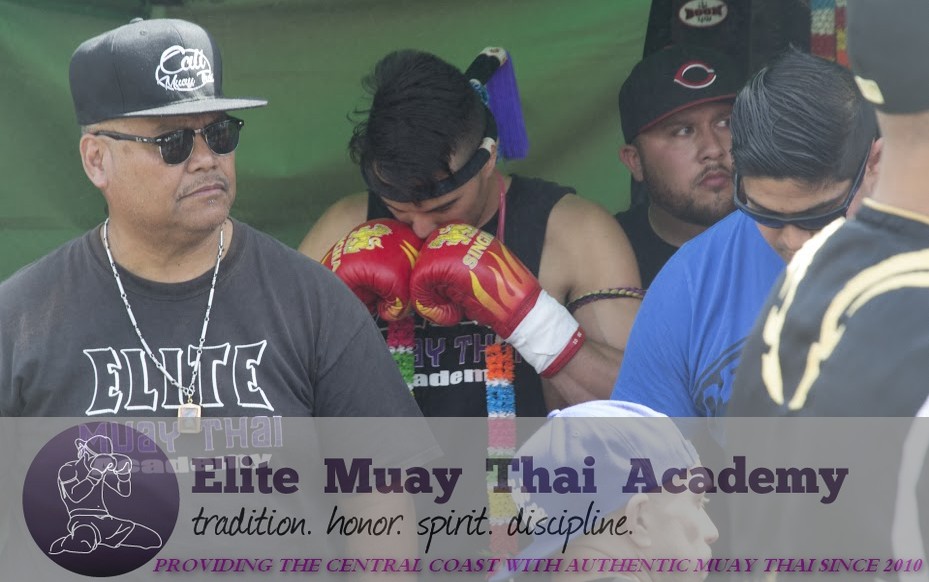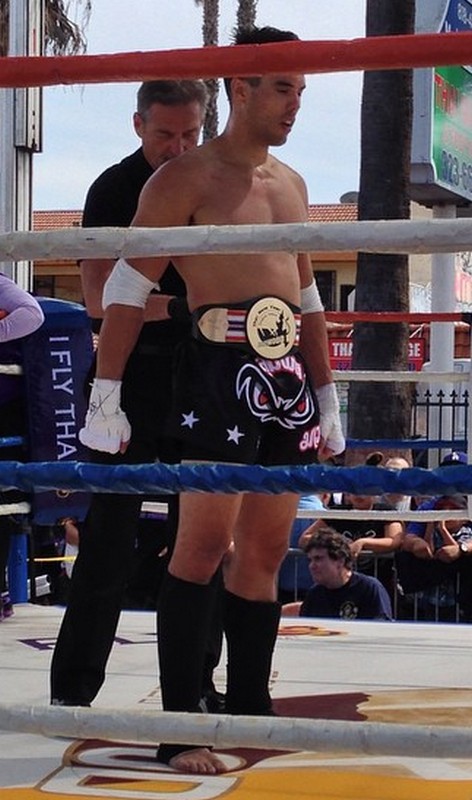 |
 |
Private lessons are available for both Muay Thai and Brazilian Jiu Jitsu
Try out a week of Free Classes. Phone: 805-534-4157~ 805-305-7512 email: skipkick@gmail.com
HISTORY AND TRADITIONSMuay Thai: Traditional Rites and CustomsBefore a young man is allowed is allowed to join a boxing camp, he must be accepted by his prospective teacher. Should there be any doubt about the youngster’s suitability or character he will be rejected or asked to apply again after some time.Once a new student is accepted, the "Wai Kruh" or "Khuen Kruh" ceremony, an important entrance ritual, must be performed. Even modern physical education colleges insist on this practice for those students taking a course in Muay Thai. The general procedure is similar in camps throughout Thailand, although many teachers have introduced slight variations to suit their own preferences.The most important part of the khuen kruh, which is held in front of a Buddha shrine flanked on either side by Muay Thai equipment, is the vow of loyalty. After the students have made their offerings of flowers, a piece of white cloth, sticks, candles and perhaps a few coins or small presents, they pray before reciting their pledge.The recital is followed by a period of meditation, Buddhist rituals and chants, and a talk by the master of ceremonies and teacher. The students are now part of a boxing "family," with the teacher as the adopted "father," and cannot change camps without permission.An inherent cultural characteristic of the Thais is the desire to show respect and gratitude, especially to those who impart knowledge, like parents and teachers. A worthy and beautiful custom is boxer’s way of paying homage to his teacher by performing the ram muay or boxing dance.This ritual differs from camp to camp, and should two fighters be seen rendering a similar performance, they are almost certainly students of the same teacher, or else their instructors have come from the same camp. If an inquiry reveals this to be true, the two boxers will on no account fight each other. This tradition is the result of strict disciplinary training and the pledge given during the khuen kruh ceremony. It ensures a feeling of close unity in the camps and villages and is meant to foster a sense of belonging to the race as a whole.The ram muay is accompanied by music and starts with wai kruh, or obedience to the teacher. The boxer kneels in the ring facing the direction of his camp, home, or birthplace. He covers his eyes with his gloves and says a short prayer while three times bowing low until his gloves touch the canvas. Now the ram muay, or boxing dance follows. It is performed in many different ways, each teacher having his own variety which he gives to a boxer according to his proficiency and experience.The ram muay also serves as a pre-fight warm-up exercise and can last as long as five minutes. Its performance is accompanied by silent prayers and the recitation of magic formulas. Some of the higher forms of these dances are difficult to perform and may earn a boxer extended applause if well executed. For those with an intimate knowledge of ram muay, details of the dance easily reveal the identity of the performer’s teacher or camp. Without initiation and the knowledge of the secret words, jealously guarded by each boxer, its performance is quite useless.One can often see a boxer wearing a string or piece of cloth around one or both biceps. This is called the "kruang rang" and may be worn throughout the fight. It sometimes contains protective charms, a small picture of the Buddha or a saint, or an herb said to have magic properties.During the pre-fight ritual fighters also wear the "mongkon" or crown, a cord about finger-thick worn around the head. It does not belong to the fighter but is the property of the teacher, and it is considered sacred. After the completion of the ram muay and before the first round commences, the trainer bows with folded hands, says a short prayer, and lifts themongkon off the boxer’s head, blowing on his hair for good luck.A very important part of Muay Thai bouts is the music, which not only accompanies the fight itself but also the pre-fight ceremonies. The haunting sounds are heard far beyond the confines of a stadium. The "wong muay," as the four-piece band is called, consists of a reedy sounding Jawa flute, the "Pi’chawa," a pair of small brass cymbals known as "Ching," and the "Glong Kaek," two drums, one high, the other low pitched. The musicians know every move in the game and watch the fighters constantly, varying tempo and volume from slow and soothing to speedy and loud, depending on the action in the ring.History of Muay ThaiWhat little we know of early Muay Thai can be traced primarily to provincial records and writings of visitors who witnessed early bouts. Most of the accounts can be traced to the Chinese, Burmese, and Cambodian countries. The reason for such a sketchy history is a loss of records in 1767. On that date, Burmese armies attacked and destroyed Thailand's capital city of Ayuddhaya. All of the royal archives were destroyed by fire.Muay Thai is an art of self defense that uses various parts of the body. Because it is based on the principle of "doing no more than necessary to teach a lesson," it is equally well suited to be used as a competitive sport as well as a "fight to the finish." In ancient times, Thai warriors had intensive training in the art, giving them a distinct advantage in close-combat situations. Royalty, military leaders, and those common people responsible for defending the nation received regular instruction by leading exponents of the art.The origin of the art itself is as colorful as the men who practiced it. Origins trace back to the Yunnan Province in central China. Because of the Chinese invasion, the Thai race fled and was thinned out by invaders, disease, and hunger. They finally settled in Chao Phraya Valley of the Mekong River. To deal with their many enemies, the Thai leaders developed a military training program for the young men of their race. This original art was called Chupasart. This taught use of knives, swords, pikes, and later, muskets. Because of many injuries to soldiers who sparred in this system, the techniques were developed for open hand combat as well. This was the birth of Dee Muay, which later evolved into modern Muay Thai.The best known and most celebrated of the early fighting greats was Nai Khanom Otom, who, having been captured by the Burmese, regained his freedom by defeating twelve of the enemy's gladiators in an unarmed contest witnessed by the Burmese king. His story is related in many versions and appears in grade school textbooks. All stadiums in the country honor the hero by dedicating one fight a year to him. It has been established without doubt that Nai Khanom Otom was a historical figure, although no records exist of him in Thailand. Ironically, the most reliable confirmation comes from Burma.Muay Thai became part of military training during the reign of King Naresun the Great (1590-1605). He also practiced the art, and in doing so became a national hero.Muay Thai reached the height of its popularity during the reign of Pra Chao Sua, the "Tiger King" (1703-1709). Siam was at peace with her neighbors and the army was idle. Boxing became the favorite pastime of the population: with young and old, rich and poor joining fighting camps. Every village staged its own bouts. The king himself was skillful and was reported to have visited village arenas incognito to challenge and defeat the local champions and, still undetected, walk off with the prize money. According to some authorities it was customary to bind hands and forearms with strips of horse hide in order to protect one's own skin and inflict maximum damage on one's own opponent. Some of the techniques used today are said to be based on Pra Chao Sua's style of fighting.
|
|---|